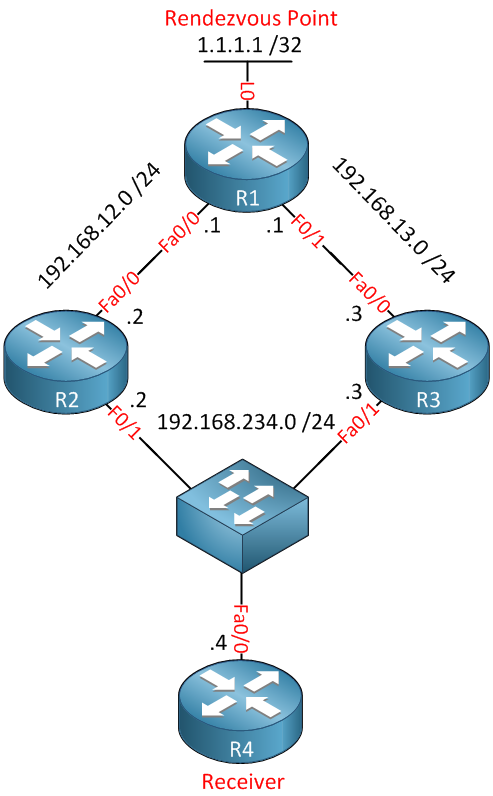Multicast PIM Designated Router
Since the DR is used to forward PIM join messages to the RP, it doesn’t do much good for multicast dense mode where we don’t have a RP. The only exception is when you use IGMPv1…in that case the PIM DR will work as the IGMP query router because IGMPv1 doesn’t have a query router election.
Don’t mix up the PIM DR with the PIM forwarder! To decide which router will forward multicast traffic we have the PIM Assert mechanism see previous blog.
Let’s take a look at the following topology to see how the DR works:
Above we see a small network with 4 routers. R1 is our RP and R4 is a receiver. As you can see R2,R3 and R4 are connected to the same multi-access network (switch). When R4 sends a PIM join message both R2 and R3 would receive it and forward it to R1. This would mean that we have 2 multicast streams which results in duplicate packets and wasted bandwidth.
To avoid this problem we will elect the DR. R2 or R3 will become the designated router and only one of them will forward the PIM join message to our RP.
Let’s configure this small network and take a close look how the DR works:
R1(config)#ip multicast-routing
R1(config)#ip pim rp-address 1.1.1.1
R1(config)#interface loopback 0
R1(config-if)#ip pim sparse-mode
R1(config)#interface fastEthernet 0/0
R1(config-if)#ip pim sparse-mode
R1(config)#interface fastEthernet 0/1
R1(config-if)#ip pim sparse-mode R2(config)#ip multicast-routing
R2(config)#ip pim rp-address 1.1.1.1
R2(config)#interface fastEthernet 0/0
R2(config-if)#ip pim sparse-mode
R2(config)#interface fastEthernet 0/1
R2(config-if)#ip pim sparse-modeR3(config)#ip multicast-routing
R3(config)#ip pim rp-address 1.1.1.1
R3(config)#interface fastEthernet 0/0
R3(config-if)#ip pim sparse-mode
R3(config)#interface fastEthernet 0/1
R3(config-if)#ip pim sparse-modeR4(config)#ip multicast-routing
R2#show ip pim neighbor
PIM Neighbor Table
Mode: B - Bidir Capable, DR - Designated Router, N - Default DR Priority,
S - State Refresh Capable
Neighbor Interface Uptime/Expires Ver DR
Address Prio/Mode
192.168.12.1 FastEthernet0/0 01:24:25/00:01:28 v2 1 / S
192.168.234.3 FastEthernet0/1 01:24:29/00:01:26 v2 1 / DR SR2#debug ip pim
PIM debugging is onR3#debug ip pim
PIM debugging is onR4(config)#interface fastEthernet 0/0
R4(config-if)#ip igmp join-group 239.1.1.1R2#
Check RP 1.1.1.1 into the (*, 239.1.1.1) entryR2#show ip mroute 239.1.1.1
IP Multicast Routing Table
Flags: D - Dense, S - Sparse, B - Bidir Group, s - SSM Group, C - Connected,
L - Local, P - Pruned, R - RP-bit set, F - Register flag,
T - SPT-bit set, J - Join SPT, M - MSDP created entry,
X - Proxy Join Timer Running, A - Candidate for MSDP Advertisement,
U - URD, I - Received Source Specific Host Report,
Z - Multicast Tunnel, z - MDT-data group sender,
Y - Joined MDT-data group, y - Sending to MDT-data group
Outgoing interface flags: H - Hardware switched, A - Assert winner
Timers: Uptime/Expires
Interface state: Interface, Next-Hop or VCD, State/Mode
(*, 239.1.1.1), 00:11:38/00:02:19, RP 1.1.1.1, flags: SP
Incoming interface: FastEthernet0/0, RPF nbr 192.168.12.1
Outgoing interface list: Nullcontinue